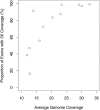Whole-genome profiling of mutagenesis in Caenorhabditis elegans
- PMID: 20439774
- PMCID: PMC2881127
- DOI: 10.1534/genetics.110.116616
Whole-genome profiling of mutagenesis in Caenorhabditis elegans
Abstract
Deep sequencing offers an unprecedented view of an organism's genome. We describe the spectrum of mutations induced by three commonly used mutagens: ethyl methanesulfonate (EMS), N-ethyl-N-nitrosourea (ENU), and ultraviolet trimethylpsoralen (UV/TMP) in the nematode Caenorhabditis elegans. Our analysis confirms the strong GC to AT transition bias of EMS. We found that ENU mainly produces A to T and T to A transversions, but also all possible transitions. We found no bias for any specific transition or transversion in the spectrum of UV/TMP-induced mutations. In 10 mutagenized strains we identified 2723 variants, of which 508 are expected to alter or disrupt gene function, including 21 nonsense mutations and 10 mutations predicted to affect mRNA splicing. This translates to an average of 50 informative mutations per strain. We also present evidence of genetic drift among laboratory wild-type strains derived from the Bristol N2 strain. We make several suggestions for best practice using massively parallel short read sequencing to ensure mutation detection.
Figures








Similar articles
-
Characterization of mutations induced by ethyl methanesulfonate, UV, and trimethylpsoralen in the nematode Caenorhabditis elegans.Biochem Biophys Res Commun. 2000 Mar 5;269(1):64-9. doi: 10.1006/bbrc.2000.2260. Biochem Biophys Res Commun. 2000. PMID: 10694478
-
N-Ethyl-N-Nitrosourea (ENU) Mutagenesis Reveals an Intronic Residue Critical for Caenorhabditis elegans 3' Splice Site Function in Vivo.G3 (Bethesda). 2016 Jun 1;6(6):1751-6. doi: 10.1534/g3.116.028662. G3 (Bethesda). 2016. PMID: 27172199 Free PMC article.
-
Ethyl methanesulfonate induces mutations in Caenorhabditis elegans embryos at a high frequency.Mutat Res. 2014 Aug-Sep;766-767:44-8. doi: 10.1016/j.mrfmmm.2014.05.011. Epub 2014 Jun 10. Mutat Res. 2014. PMID: 25847271
-
Mutagenesis.Methods Cell Biol. 1995;48:31-58. Methods Cell Biol. 1995. PMID: 8531732 Review.
-
A review of the genotoxicity of 1-ethyl-1-nitrosourea.Mutat Res. 1993 Jul;297(1):3-38. doi: 10.1016/0165-1110(93)90005-8. Mutat Res. 1993. PMID: 7686271 Review.
Cited by
-
RNA-seq analysis of the C. briggsae transcriptome.Genome Res. 2012 Aug;22(8):1567-80. doi: 10.1101/gr.134601.111. Epub 2012 Jul 6. Genome Res. 2012. PMID: 22772596 Free PMC article.
-
UBR-5, a Conserved HECT-Type E3 Ubiquitin Ligase, Negatively Regulates Notch-Type Signaling in Caenorhabditis elegans.G3 (Bethesda). 2016 Jul 7;6(7):2125-34. doi: 10.1534/g3.116.027805. G3 (Bethesda). 2016. PMID: 27185398 Free PMC article.
-
Establishing developmental genetics in a self-fertilizing fish (Krytolebias marmoratus).Integr Comp Biol. 2012 Dec;52(6):781-91. doi: 10.1093/icb/ics052. Epub 2012 Apr 27. Integr Comp Biol. 2012. PMID: 22544288 Free PMC article.
-
A Rapid, SuperSelective Method for Detection of Single Nucleotide Variants in Caenorhabditis elegans.Genetics. 2020 Oct;216(2):343-352. doi: 10.1534/genetics.120.303553. Epub 2020 Aug 17. Genetics. 2020. PMID: 32817008 Free PMC article.
-
Tubular Excretory Canal Structure Depends on Intermediate Filaments EXC-2 and IFA-4 in Caenorhabditis elegans.Genetics. 2018 Oct;210(2):637-652. doi: 10.1534/genetics.118.301078. Epub 2018 Jun 26. Genetics. 2018. PMID: 29945901 Free PMC article.
References
-
- Acevedo-Arozena, A., S. Wells, P. Potter, M. Kelly, R. D. Cox et al., 2008. ENU mutagenesis, a way forward to understand gene function. Annu. Rev. Genomics Hum. Genet. 9 49–69. - PubMed
-
- Anderson, K. V., 2000. Finding the genes that direct mammalian development: ENU mutagenesis in the mouse. Trends Genet. 16 99–102. - PubMed
-
- Anderson, P., 1995. Mutagenesis. Methods Cell Biol. 48 31–58. - PubMed
-
- Barstead, R. J., and D. G. Moerman, 2006. C. elegans deletion mutant screening. Methods Mol. Biol. 351 51–58. - PubMed
Publication types
MeSH terms
Substances
Grants and funding
LinkOut - more resources
Full Text Sources
Miscellaneous

